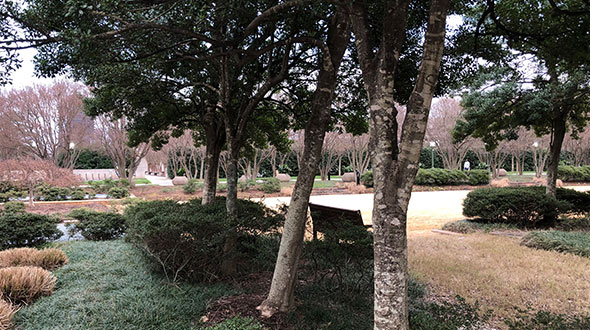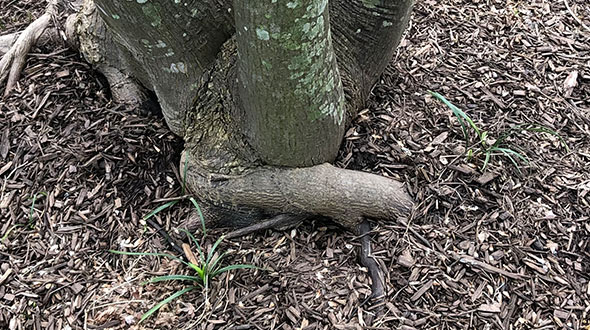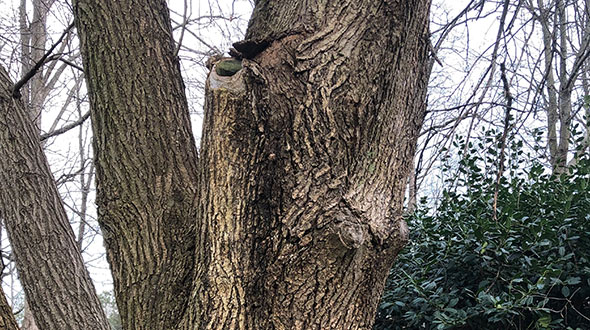
If you don’t know what to look for, a tree defect can cause a significant hazard for you. By knowing how to identify and manage severe tree defects, you can prevent catastrophic and life-threatening damages from branch and tree falls.
toddsmariettatreeservices.com gathered information on 7 tree defects, how to identify them, and how to manage them before they become deadly.
Deadly Tree Defects
The following tree defects are structural in nature and can result from disease, poor tree architecture, or injury. When such defects cause a tree or branch to fail, the damages or injuries to structures and people can be utterly catastrophic.
Here’s how to identify and manage these deadly defects:
Cracks in Branches or Tree Trunks
Cracks in your tree can represent weakness in the tree’s structure or internal decay rotting away at the inner wood of the tree.
How To Identify Cracks – When you can see past the bark of the tree into the lighter colored inner wood, you have identified a crack. Cracks can follow the grain of the tree (as if the tree was splitting) or intersect it (as if the tree was breaking), both types of breaks require your immediate attention.
How To Manage Cracks – If the crack is located on a branch away from the branch collar, it can be pruned off the tree at the root collar. However, if the crack is located on the tree trunk, you may have to have the tree removed to eliminate the danger it poses.
When it comes to cracks on a tree, it is highly recommended to call a professional tree service to perform a hazard assessment and offer a reasonable course of action. Read more about tree hazard assessments at toddsmariettatreeservices.com/why-do-i-need-tree-hazard-assessment/
Weak Branch Unions
Some branches on trees may grow in a way that makes them a severe hazard as the tree grows larger and heavier.
How To Identify Weak Branch Unions – Look at the area where the branch meets the tree trunk. There “should” be what is known as a branch collar or branch bark ridge (strong attachment). If this branch collar is absent, this is known as included bark in the branch attachment (weak attachment).

How To Manage Weak Branch Unions – Prune out branches with weak connections to the tree trunk. As the tree and branches grow, so shall their weight. When these branches spontaneously detach from the tree, they can wreak havoc on lower branches, and whatever else is below.
Read more about tree pruning and cutting at toddsmariettatreeservices.com/right-time-cutting-pruning-emergency-tree-removal/
Poor Tree or Crown Architecture
Poorly-maintained or unmaintained trees can present several worrisome defects. Perhaps the most troubling of those defects is the growth of multiple leaders. Multiple leaders are the vertical branches of a tree from which the horizontal branches form the crown.
How To Identify Poor Tree Architecture – Stand far enough away from the tree in question, so that you can see the majority of the crown and the branches that lead into it from the trunk. If the tree looks lopsided (more branches and foliage on one side of the crown), or there are multiple leaders, the tree’s architecture should be addressed.
The lower on the trunk that multiple leaders begin, the more unstable the tree will be as it grows.

How To Manage Poor Tree Architecture – For trees with a disproportionate crown, a professional tree service should be hired to thin the crown and restore a sense of balance to the tree.
For trees growing multiple leaders, especially those trees growing them low to the ground, one leader should be chosen to remain while the others are pruned from the tree. This type of management is most effective when the tree is younger.
Leaning Trees
Trees that lean can have an ominous appearance. If that lean is greater than 15 degrees, removal of the tree should be considered for damage and injury prevention. When it comes to the direction of a fall, avoid basing your assumption on the direction of the lean, wind and holding wood can cause it to fall in any direction, including opposite the direction of the lean.
How To Identify A Corrected Lean – A corrected lean happens when a tree has been leaning for a very long time. The base of the tree will lean, but the trunk corrects itself as the tree grows. This may appear as a curvature or a hard angle (crook) where the tree corrected itself.
As the tree ages, a natural lean may slowly increase due to the increasing weight of the trunk and crown.
How To Manage A Corrected Lean – Corrected leans are relatively common in nature and don’t require immediate attention. However, if it becomes an uncorrected lean, the tree may have to be removed.
How To Identify An Uncorrected Lean – These leans can occur when the root plate destabilizes, cracks on the trunk increase in size, or decay at the top or bottom of the trunk cause the crown or entire tree to lean.

How To Manage An Uncorrected Lean – Trees with an uncorrected lean are extremely hazardous and have already begun to fall. These trees should be addressed and removed by a professional tree service immediately.
Tree Decay
Tree decay is one of the most common contributors to tree failure during severe weather events, and in advanced cases, sudden tree failure.
How To Identify Tree Decay – When fungal fruiting structures or mushroom conks begin to bloom out of the trunk or root flare, there is decay at work deep within the tree. This is an incredibly dangerous situation that should never be overlooked or ignored.

How To Manage Tree Decay – Once you have identified the signs of decay, have a tree risk assessment performed as quickly as possible to determine when the tree should be removed.
Tree Root Problems
While tree roots may be buried, their effect on trees becomes very evident, making identification fairly easy.
How To Identify Tree Root Problems – Two common root problems can lead to the failure and falling of a tree. One problem is stem girdling roots (SGRs), these roots encircle the tree trunk just under the ground. As the tree grows, the encircled roots also grow and thicken. The SGRs eventually cause the complete hydraulic failure of the tree.
Look at the root flare, if you see one of the flares making a hard turn “hugging” the curvature of the trunk, it is likely encircling the trunk. Another sign is the sudden wilting and death of the entire crown of an otherwise healthy tree.

Root rot can be caused by any one of several disease pathogens. It can also occur in soaked soil with poor drainage. When root rot is present, you may see an entire section of the tree’s crown wilt and die. In severe cases, where the entire root plate is affected, the whole crown may suddenly wilt and die.
How To Manage Tree Root Problems – For SGRs, these roots must be cut away from the tree before killing it. For root rot, upon detection, a professional tree service should be called to assess the severity of the damage and whether or not the tree can be salvaged.
Tree Trunk Cankers
Cankers can appear on and affect tree trunks and branches. They are areas of tissue that have been killed by fire, sunscald, disease, insects, animal, and/or human activity.
How To Identify Cankers – Cankers appear as a darkened or sunken area of bark. This affliction causes an area of previously living bark to die and is usually associated with decay. Some cankers will ooze sap or fluids produced from the decaying of sapwood.

How To Manage Cankers – Cankers on branches should be pruned off the tree when discovered. This prevents any disease or pathogen from spreading further within the tree. Cankers on the trunk are more problematic and should be treated the same as a crack.
Cankers on tree trunks weaken the structure of the tree and are highly susceptible to insect infestation and disease. It is highly recommended that a professional tree service be called to perform a tree hazard assessment and recommend preventative measures.
Managing Tree Defects
In this article, you discovered 7 deadly tree defects, how to identify them, and what actions to take before they cause catastrophic loss and/or injury.
By taking immediate action to reverse or eliminate tree defects, you are ensuring the safety of your property and eliminating a potentially deadly tree failure.
Ignoring the signs of tree defects can result in costly damages to your property, structures, and vehicles. If the defect is coupled with a disease or infestation, your failure to respond may spread such problems to other trees and plant life on your property.
Sources:
forestpathology.org/hazard-trees/hazard-tree-defects/
in.gov/dnr/forestry/files/04_Identify_and_Manage.pdf
archive.lib.msu.edu/tic/holen/article/2013mar16.pdf
forestryimages.org/browse/Bareas.cfm?domain=23
Todd’s Marietta Tree Services
(678) 505-0266

No comments:
Post a Comment